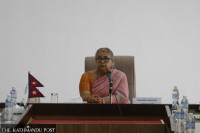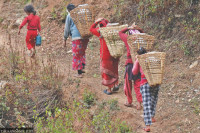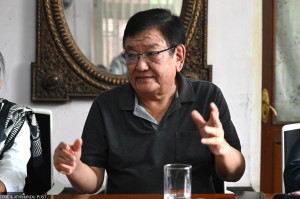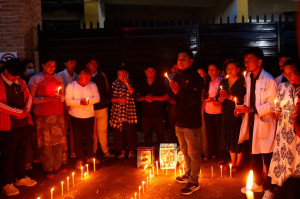Opinion
What a waste
The Cricket Association of Nepal has failed young Nepali cricketing talents
Nitish Raj Pathak
Millions of Nepalis were overjoyed when recently the Under-19 (U19) national cricket team qualified for the next year’s U19 World Cup in Bangladesh after defeating Ireland. If the past is any indication, the Under-19 national cricket team will not disappoint the country. These boys will play the mega event, gain experience, return home and soon disappear despite their promising talent due to Nepal’s poor domestic cricket structure. On the other hand, the boys from Ireland who were taunted by the Nepalis in the recent tournament will return back to their strong domestic structure and, with tie-ups with England, a cricket powerhouse, someday play in the top flight.
Back in 2006, Nepal played in the U19 World Cup of 2006 and ended its campaign as the ninth best team ahead of test-playing nations like New Zealand and South Africa. Teams with players like Eoin Morgan, Wayne Parnel and Craig Kieswetter could not defeat the Nepali team which had players like Paras Khadka, Gyanendra Malla, Amrit Bhattarai, Basanta Regmi, Kanishka Chaugai, Mahesh Chhetri and Sharad Veswakar. However, these Nepali players who performed so well in the 2006 tournament have only played in one World Cup after that.
Inadequate structures
If anything, the U19 World Cup of 2006 showed that Nepali players like Khadka and Chaugai, Malla, Bhandari and Regmi were at least as talented and skillful as the international players if not better, but their talents remained unpolished. Compared to Khadka, who after the World Cup had nothing to do, young Morgan received several training sessions and played County Cricket. If Khadka had been provided with similar opportunities, he would have been better than what he is today.
The Nepali cricket team, the ‘dark horse’ in the 2006 World Cup defeated many Test-playing nations. Ireland and Scotland hardly finished ahead of Nepal in the tournament, but look where they stand today. Back then, Nepali team was the best associate team in the U19 level. But these successes could not be replicated in the senior team. There are three possible reasons for this: lack of proper domestic cricket structure, lack of regular trainings from quality coaches, and the unprofessional manner in which the Cricket Association of Nepal (CAN) functions.
Let us compare Kanishka Chaugai, Nepal’s team captain in 2006, who was dubbed as the best batsman among associate nations by Nepali U19 coach Jagat Tamata and New Zealand’s player Martin Guptil. Chaugai had a much more successful U19 World Cup than Guptil; Nepal even defeated New Zealand. The potential of both these players was seemingly comparable as both of them were equally talented. But after that tournament, Chaugai played about 15 matches in 2007, while Guptil played many more. Nowadays, the name of Chaugai is barely heard in Nepali cricket, whereas Guptil was the highest run scorer in the One Day International Cricket World Cup 2015.
Every upcoming cricket team in 2006 built its future squad around its young players. Ireland, for example, had players like William Porterfield and Gary Wilson in its U19 World Cup team and built its senior squad around them afterwards. Now, Ireland is one of the best associate teams in international cricket. The case of Bangladesh is no different. The Bangladeshi team got stronger when its U19 World Cup stars like Shakib Al Hasan, Tamim Iqbal and Musfiqur Rahim were selected in the national team. But the Cricket Association of Nepal failed the stars of 2006 U19 Nepali cricket team. It did not provide the team with the right platform and exposure.
CAN’s role
Therefore, the current world cup qualification by the U19 Nepali cricket team will mean nothing if these talented young lads never play at the same level again. The team’s victory will fail to serve any purpose if Raju Rijal, the current Captain of U19 team, finishes the tournament as the best player of the world, but never gets to sharpen his cricketing skills thereafter. If CAN does not provide these young players with adequate exposure, trainings, and the chance to play games with the top teams, Nepal might qualify for the U19 World Cup every now and then, but we will always choke when it comes to the top-level international cricket. The U19 cricket players have already proved their potential by winning the qualifiers. Now, it is the CAN’s and government’s duty to build a future around these cricketing talents. It is time we put Pubudu Dassanayake’s, the current coach of the national team, plan into action of building a strong domestic cricketing structure where no upcoming talented players will go unnoticed. The players should get proper trainings and exposure opportunities in international cricket venues such as the Lord’s Cricket Ground in London, the UK.
Since India is our neighbouring country with a rich cricketing culture, CAN must tie up with cricket academies there so that our players can play against top talents of India from a tender age. If we fail to do so, talented players will be sitting at home, disappointed and frustrated wondering about all that could have accomplished had they got the appropriate opportunities to sharpen their talents.
Pathak is Secretary of National Para-Athletics Association Nepal




 24.12°C Kathmandu
24.12°C Kathmandu









